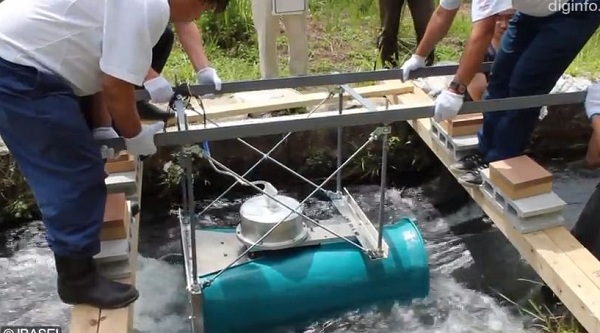What is it about offbeat, unproven, renewable energy devices? We in the green media trip over ourselves to write about them, often with little scrutiny. (See my piece last year on the Strait Power hydrokinetic generator, although that one did at least have some academic cred.)
But I’m not going to let that happen with the Ibasei Cappa. Nope. Not gonna do it for a hydropower system that would cost $50,000 or more to produce one meager kilowatt of power.

You have heard about the Ibasei Cappa, right? With excellent pictures, colorful diagrams and a video that sounds like it’s a news report (maybe it is, maybe it isn’t; hard to tell), this Japanese mini-hydropower unit has gotten an explosion of attention from the green press in the past week. But as cute as it is, the fact is we have no idea how well it works – and even if it does work as well as advertised, the economics of it are absurd.
First let’s make clear: River kinetic hydropower is a renewable energy source with some good possibilities, in large part because by definition it doesn’t require significant infrastructure development, like dams or powerhouses. Small units can be used in multiple arrays to scale up output, and assuming a good location with a steady flow, power can be produced around the clock, eliminating the need for expensive storage.
The Cappa is said to have a “special housing called a diffuser” to make it extra efficient, but this isn’t anything groundbreaking for small-scale water current turbines. Really, the only thing that seems to make the Ibasei Cappa special – beyond the very important fact that it provided nice graphics for us to work with – is the price, reported to be “about the same as a compact car” for a single device that can put out 250 watts in 2 meters per second (4.5 mph) of water flow, a good flow. With control losses taken into account, according to reports, “five of these can deliver about 1 kW.”
A small compact car might be $15,000, but let’s give the Cappa a break and say $10,000. Five x $10,000 = $50,000 for 1 kW.
You could put in a lot of solar – several times that output – with storage, for 50 Gs.
But maybe you’re part of a research team out at a remote site in Alaska for several weeks. Even a little bit of power would come in handy to run communications and research gear, lights, computers, etc. Fair enough. Have one of these flown in with the rest of your stuff, set it up in a stream near camp and take advantage of a couple of hundred watts of the world’s most expensive electricity. Maybe your grant will pay for it. A few questions, though.
Will the Cappa quickly become tangled with debris? An Australian study of similar systems a couple of years ago noted: “(S)everal deployments have experienced major problems with debris attaching to the turbines, resulting in interrupted operation. Excessive work in removing debris and furling result in frequent power cuts, a disadvantage in systems supplying AC power on demand, and this problem impedes the acceptance of hydrokinetic turbines in remote community electrification.”
Plus, what about the environmental impact?
And will the Cappa really produce anywhere near the power the company says it will?
And how long will it last? Degradation is a big issue with such devices.
OK. I’m being unduly curmudgeonly here. It’s not possible to give a rigorous assessment of every design that comes down the pike. But still. I wonder if we can expect the renewable energy skeptics to take our advocacy and our journalism seriously if it’s so credulous.
Meanwhile, if you’re truly interested in exploring small-scale water current turbines, I highly recommend this 24-page PDF report by the Zero Emissions Resource Organization out of Norway. It explains the technology quite well, and gives information about several well-established companies that appear to be able to offer some history and documentation to back up their products.